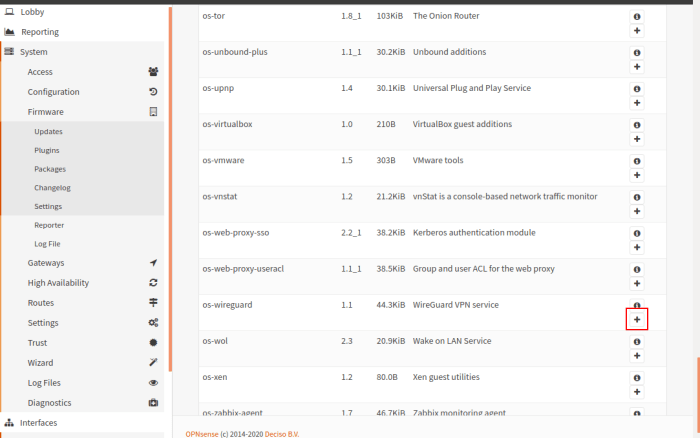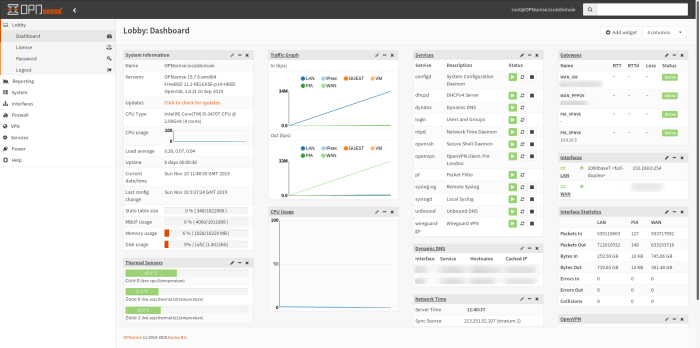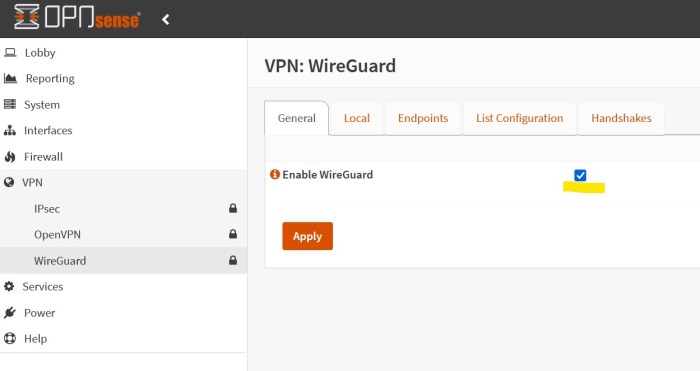In the realm of network security, WireGuard has emerged as a game-changer, offering an unparalleled blend of speed, security, and ease of use. When combined with the powerful OPNsense firewall, WireGuard unleashes its full potential, providing an impenetrable barrier against cyber threats while optimizing network performance.
This comprehensive guide will delve into the intricacies of WireGuard on OPNsense, empowering you with the knowledge to configure, manage, and troubleshoot this cutting-edge VPN solution. From installation to advanced features, we will explore every aspect of WireGuard on OPNsense, ensuring you can harness its full capabilities to safeguard your network.
WireGuard on OPNsense

WireGuard is a modern VPN protocol that offers several advantages over traditional protocols like OpenVPN and IPsec. It is faster, more efficient, and easier to configure. WireGuard is also more secure than traditional VPN protocols, as it uses state-of-the-art cryptography.WireGuard
works by establishing a secure tunnel between two devices. This tunnel is encrypted using a strong cipher, and all data that passes through the tunnel is protected from eavesdropping. WireGuard is also very efficient, as it uses a lightweight protocol that does not require a lot of overhead.
This makes it ideal for use on devices with limited resources, such as smartphones and tablets.
Benefits of Using WireGuard on OPNsense
There are several benefits to using WireGuard on OPNsense, including:
- Faster speeds: WireGuard is significantly faster than traditional VPN protocols, making it ideal for streaming video and other bandwidth-intensive activities.
- More efficient: WireGuard uses a lightweight protocol that does not require a lot of overhead, making it ideal for use on devices with limited resources.
- Easier to configure: WireGuard is much easier to configure than traditional VPN protocols, making it a good choice for users who are not familiar with VPN technology.
- More secure: WireGuard uses state-of-the-art cryptography to protect data from eavesdropping, making it a more secure choice than traditional VPN protocols.
How to Configure WireGuard on OPNsense
Configuring WireGuard on OPNsense is relatively easy. The following steps will guide you through the process:
- Install the WireGuard package from the OPNsense package repository.
- Create a new WireGuard interface in the OPNsense web interface.
- Configure the WireGuard interface with the appropriate settings.
- Add peers to the WireGuard interface.
- Activate the WireGuard interface.
Once you have completed these steps, you will be able to use WireGuard to connect to your OPNsense firewall from anywhere in the world.
Installing WireGuard on OPNsense
Installing WireGuard on OPNsense is a straightforward process that can be completed in a few simple steps. Follow the instructions below to get started.
Prerequisites
Before you begin, ensure that you have the following:
- An OPNsense firewall with an active internet connection.
- Administrative access to the OPNsense web interface.
Installation
- Log in to the OPNsense web interface and navigate to System > Firmware > Plugins.
- Click on the Available Plugins tab and search for “WireGuard“.
- Click on the Install button next to the WireGuard plugin.
- Once the plugin is installed, click on the Restart button to apply the changes.
Potential Issues
- If you encounter any errors during installation, check the OPNsense logs for more information.
- If you are unable to connect to the WireGuard server after installation, ensure that the firewall rules are configured correctly.
Configuring WireGuard on OPNsense
WireGuard on OPNsense offers a wide range of configuration options, allowing users to tailor their VPN to specific requirements. These options include:
- Interface settings: Configure the network interface that WireGuard will use, including IP address, subnet mask, and gateway.
- Peer settings: Define the parameters for connecting to other WireGuard peers, including public key, IP address, and allowed IP ranges.
- Firewall rules: Set up firewall rules to allow or deny traffic through the WireGuard interface.
- NAT settings: Configure network address translation (NAT) to allow devices on the local network to access the internet through the WireGuard interface.
- DNS settings: Specify the DNS servers to be used by devices connected to the WireGuard interface.
Security Implications of Configuration Options
The security of a WireGuard configuration depends on the specific options chosen. For example:
- Using a strong public key for peer authentication is essential to prevent unauthorized access.
- Limiting the allowed IP ranges for peers restricts the scope of potential attacks.
- Implementing firewall rules can block unwanted traffic and protect the local network.
Therefore, it is crucial to carefully consider the security implications of each configuration option and choose settings that balance security and usability requirements.
Managing WireGuard on OPNsense
Managing WireGuard connections on OPNsense is a straightforward process. You can add, remove, and modify WireGuard peers, and troubleshoot common issues with ease.
To manage WireGuard connections, navigate to System > WireGuard in the OPNsense web interface.
Adding a WireGuard Peer
To add a WireGuard peer, click the Add button. Enter the following information:
- Name: A unique name for the peer.
- Public Key: The public key of the peer you want to connect to.
- Allowed IPs: The IP addresses that the peer is allowed to access.
- Endpoint: The IP address and port of the peer you want to connect to.
Click Save to add the peer.
Removing a WireGuard Peer
To remove a WireGuard peer, select the peer and click the Delete button.
Modifying a WireGuard Peer
To modify a WireGuard peer, select the peer and click the Edit button. Make the necessary changes and click Save .
Troubleshooting WireGuard Issues
If you are having trouble connecting to a WireGuard peer, check the following:
- Ensure that the public key of the peer is correct.
- Make sure that the allowed IPs for the peer include the IP address of the device you are trying to connect from.
- Verify that the endpoint of the peer is correct.
- Check the firewall rules to ensure that WireGuard traffic is allowed.
If you are still having trouble, you can consult the OPNsense documentation or the WireGuard website for more help.
Advanced WireGuard Features on OPNsense
WireGuard on OPNsense offers a range of advanced features that can enhance security, performance, and flexibility. These features include:
- Keepalive: Keeps connections alive by sending periodic packets, ensuring uninterrupted communication even during periods of inactivity.
- Pre-shared keys (PSK): Simplifies key management by using a shared secret instead of certificates.
- Allowed IPs: Restricts access to the VPN by specifying the allowed IP addresses for each peer.
- DNS settings: Configures custom DNS servers for the VPN connection, providing greater control over DNS resolution.
- Port forwarding: Allows specific ports to be forwarded through the VPN, enabling access to internal services from remote locations.
These features provide additional customization options and enhance the overall functionality of WireGuard on OPNsense.
Keepalive
Keepalive packets prevent connections from timing out due to inactivity. By sending periodic packets, OPNsense ensures that connections remain active even when there is no active traffic. This is especially useful for maintaining connections over unstable networks or when devices are frequently going into sleep mode.
Integrating WireGuard with Other Services on OPNsense
Integrating WireGuard with other services on OPNsense extends its capabilities and allows for more robust network configurations. Here are some examples:
Firewall Rules
- WireGuard can be integrated with firewall rules to control traffic flow. For instance, you can create firewall rules that allow specific traffic from the WireGuard interface to access internal resources.
- You can also use firewall rules to restrict traffic from the WireGuard interface to specific destinations or ports.
NAT
- WireGuard can be used in conjunction with NAT to translate private IP addresses on the WireGuard network to public IP addresses. This allows devices on the WireGuard network to access the internet.
- NAT can also be used to map specific ports on the WireGuard interface to different ports on the internal network.
Other Services
- WireGuard can be integrated with other services on OPNsense, such as DHCP, DNS, and OpenVPN. This allows for a more seamless and secure network configuration.
- For example, you can use DHCP to assign IP addresses to devices on the WireGuard network, and DNS to resolve domain names.
The integration of WireGuard with other services on OPNsense provides numerous benefits, including:
- Enhanced security: Integrating WireGuard with firewall rules and NAT provides additional layers of security to your network.
- Improved flexibility: Integrating WireGuard with other services allows for more flexible and customizable network configurations.
- Simplified management: Integrating WireGuard with other services simplifies network management by centralizing configuration and control.
However, there are also some limitations to consider:
- Complexity: Integrating WireGuard with other services can increase the complexity of your network configuration.
- Performance: Integrating WireGuard with other services may impact network performance, especially if the services are resource-intensive.
- Compatibility: Integrating WireGuard with other services may require additional configuration or compatibility checks.
Performance and Security Considerations for WireGuard on OPNsense
WireGuard is a high-performance and secure VPN protocol that offers several advantages over traditional VPN protocols like IPsec and OpenVPN. However, there are some performance and security considerations to keep in mind when using WireGuard on OPNsense.
Performance Considerations
WireGuard is generally faster than other VPN protocols, but its performance can be affected by several factors, including:
- The number of concurrent connections
- The size of the packets being transmitted
- The encryption algorithm used
- The hardware resources available on the OPNsense firewall
To optimize WireGuard performance, it is important to:
- Limit the number of concurrent connections
- Use smaller packet sizes
- Use a faster encryption algorithm, such as ChaCha20-Poly1305
- Ensure that the OPNsense firewall has sufficient hardware resources
Security Considerations
WireGuard is a secure VPN protocol, but it is important to configure it correctly to ensure maximum security. Some of the security considerations to keep in mind include:
- Using strong encryption algorithms
- Enabling perfect forward secrecy
- Using a strong key exchange mechanism
- Limiting access to the WireGuard interface
By following these performance and security considerations, you can ensure that WireGuard on OPNsense provides a fast and secure VPN connection.
Case Studies and Examples of Using WireGuard on OPNsense

WireGuard has gained popularity in various real-world scenarios due to its simplicity, performance, and security features. Here are a few examples:Remote Access for Employees: WireGuard can provide secure remote access for employees working from home or on the go. It allows them to connect to the company network as if they were physically present, enabling them to access internal resources and applications securely.Site-to-Site
VPNs: WireGuard is an excellent choice for establishing site-to-site VPNs between multiple locations. It provides a fast and reliable connection between remote offices or data centers, allowing for secure data sharing and collaboration.Cloud Connectivity: WireGuard can be used to connect on-premises infrastructure to cloud services securely.
It allows organizations to extend their network to the cloud and access cloud-based resources as if they were local.Benefits of Using WireGuard in These Scenarios:*
-*Enhanced Security
WireGuard uses modern cryptography algorithms and protocols, providing strong encryption and protection against eavesdropping and other security threats.
-
- -*Improved Performance
WireGuard is known for its exceptional performance, delivering high speeds and low latency, even over long distances or congested networks.
- -*Improved Performance
-*Simplified Configuration
WireGuard’s user-friendly interface and straightforward configuration process make it easy to set up and manage, even for non-technical users.
Challenges and Best Practices:*
-*Firewall Configuration
Ensure that the firewall is configured correctly to allow WireGuard traffic.
-
- -*Key Management
Securely generate, store, and distribute WireGuard keys to authorized users.
- -*Key Management
-*Monitoring and Troubleshooting
Implement monitoring and troubleshooting mechanisms to detect and resolve any issues promptly.
-*Regular Updates
Keep WireGuard software up to date with the latest security patches and improvements.
Troubleshooting WireGuard on OPNsense
Troubleshooting WireGuard on OPNsense can be challenging, but it’s essential to ensure a reliable and secure connection.
Here are some tips to diagnose and resolve common issues:
First, verify that WireGuard is installed and enabled on both devices. Check the firewall rules to ensure that UDP port 51820 is open for WireGuard traffic.
Connection Problems
- Check the IP addresses and ports configured for WireGuard. Ensure they match on both devices.
- Verify that the private keys are correct and match on both devices.
- Check the firewall logs to identify any blocked connections.
Configuration Errors
- Review the WireGuard configuration files for any typos or errors.
- Ensure that the AllowedIPs and Endpoint settings are configured correctly.
- Check that the MTU size is set appropriately for your network.
Advanced Troubleshooting
- Use the WireGuard debug log to identify specific error messages.
- Capture network traffic using tools like tcpdump or Wireshark to analyze connection attempts.
- Contact the WireGuard community forums or the OPNsense support team for assistance.
Resources for Further Learning
Staying updated with the latest WireGuard developments is crucial to ensure optimal performance, security, and compatibility. Here are some valuable resources to enhance your knowledge and stay informed:
Documentation
[WireGuard on OPNsense Official Documentation](https
//docs.opnsense.org/manual/how-tos/wireguard.html) provides comprehensive instructions and configuration guidelines.
[WireGuard Website](https
//www.wireguard.com/) offers technical specifications, release notes, and tutorials.
Tutorials
[Installing and Configuring WireGuard on OPNsense](https
//www.youtube.com/watch?v=5Z3rX3f4z24) provides a step-by-step video guide.[WireGuard with OPNsense
Complete Setup Guide](https
//www.thomas-krenn.com/en/wiki/WireGuard_with_OPNsense_-_Complete_Setup_Guide) offers detailed written instructions.
Community Forums
[OPNsense Community Forum](https
//forum.opnsense.org/) allows you to connect with other users and experts to discuss WireGuard and other OPNsense-related topics.
[WireGuard Mailing List](https
//lists.zx2c4.com/mailman/listinfo/wireguard) provides a platform for discussions, announcements, and troubleshooting.
Final Thoughts

As we conclude our journey through the world of WireGuard on OPNsense, it is evident that this dynamic duo offers a compelling solution for enhancing network security and performance. By embracing the advanced features and integration capabilities of WireGuard on OPNsense, you can unlock a new level of protection and efficiency for your network.
Whether you are a seasoned IT professional or a novice seeking to bolster your network security, this guide has equipped you with the knowledge and tools to harness the full potential of WireGuard on OPNsense.